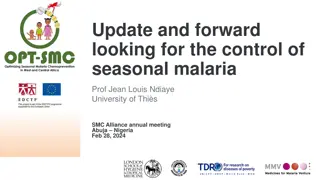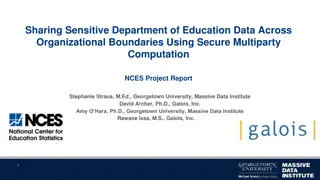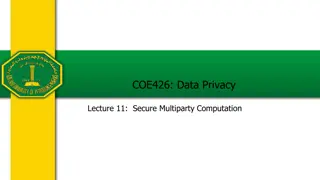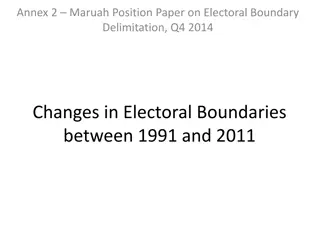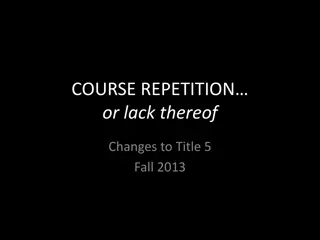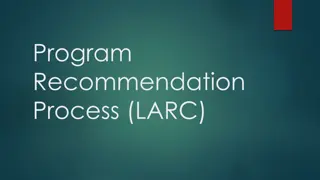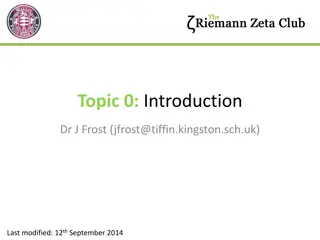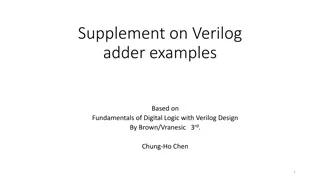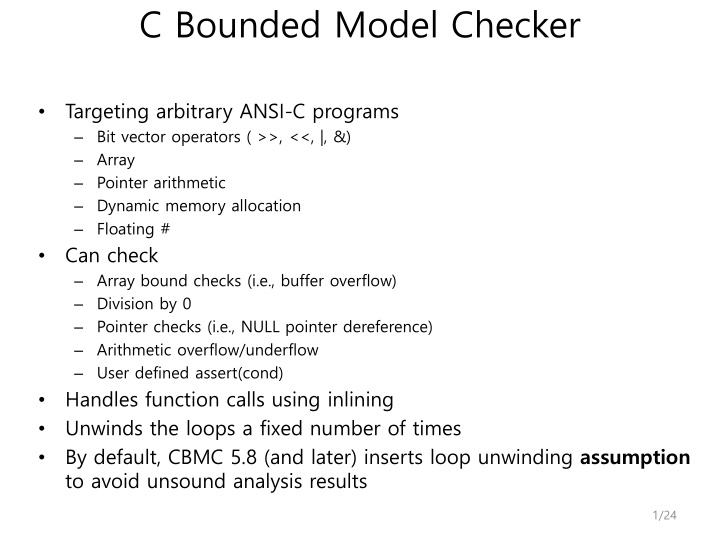
Exploring C Bounded Model Checker: Verifying ANSI-C Programs
Dive into the capabilities of the C Bounded Model Checker (CBMC) designed for verifying arbitrary ANSI-C programs, including handling bit vector operators, dynamic memory allocation, and loop unwinding. Discover how CBMC assists in identifying bugs and ensuring code correctness.
Download Presentation

Please find below an Image/Link to download the presentation.
The content on the website is provided AS IS for your information and personal use only. It may not be sold, licensed, or shared on other websites without obtaining consent from the author. If you encounter any issues during the download, it is possible that the publisher has removed the file from their server.
You are allowed to download the files provided on this website for personal or commercial use, subject to the condition that they are used lawfully. All files are the property of their respective owners.
The content on the website is provided AS IS for your information and personal use only. It may not be sold, licensed, or shared on other websites without obtaining consent from the author.
E N D
Presentation Transcript
C Bounded Model Checker Targeting arbitrary ANSI-C programs Bit vector operators ( >>, <<, |, &) Array Pointer arithmetic Dynamic memory allocation Floating # Can check Array bound checks (i.e., buffer overflow) Division by 0 Pointer checks (i.e., NULL pointer dereference) Arithmetic overflow/underflow User defined assert(cond) Handles function calls using inlining Unwinds the loops a fixed number of times By default, CBMC 5.8 (and later) inserts loop unwinding assumption to avoid unsound analysis results 1/24
CBMC Options (cbmc --help) (1/2) --function <f> Set a target function to model check (default: main) --unwind n Unwinding all loops n-1 times and recursive functions n times -unwindset f.0:64,main.1:64,max_heapify:3 Unwinding the first loop in f 63 times, the second loop in main 63 times, and max_heapify (a recursive function) 3 times --show-loops Show loop ids which are used in unwindset --trace To generate a counter example Example: cbmc -unwindset f.0:64,main.1:64,max_heapify:3 max-heap.c 2/24
CBMC Options (cbmc --help) (2/2) --unwinding-assertions Convert unwinding assumption __CPROVER_assume(!(i<10)) into assert(!(i<10)) --dimacs Show a generated Boolean SAT formula in DIMACS format --bounds-check, --div-by-zero-check, --pointer-check Check corresponding crash bugs --memory-leak-check, --signed-overflow-check, --unsigned- overflow-check Check corresponding abnormal behaviors 3/24
Loop Unwinding Example 1 int main() { 2 int sum=0, i=0; 3 for(i=0; i < 3; i ++ ) { 4 sum+=i; 5 } 6 assert(0); // cbmc --unwind 3 does NOT report the violation 7 // cbmc --unwind 4 does report the violation 8 // cbmc --unwindset main.0:4 report the violation 9 } moonzoo@verifier3:$ cbmc --unwinding-assertions --unwind 3 loop1.c ... Solving with MiniSAT 2.2.1 with simplifier 72 variables, 11 clauses ... Runtime decision procedure: 0.000262811s ** Results: [main.unwind.0] unwinding assertion loop 0: FAILURE loop1.c function main [main.assertion.1] line 6 assertion 0: SUCCESS ** 1 of 2 failed (2 iterations) VERIFICATION FAILED 4/24
Procedure of Software Model Checking in Practice 0. With a given C program (e.g.,int bin-search(int a[],int size_a, int key)) 1. Define a requirement (i.e., assert(i>=0 -> a[i]== key) where i is a return value of bin-search()) 2. Model an environment/input space of the target program, which is non-deterministic Ex1. pre-condition of bin-search() such as input constraints Ex2. For a target client program P, a server program should be modeled as an environment of P Interaction Environ- ment Target program A program execution can be viewed as a sequence of interaction between the target program and its environment 3. Tuning model checking parameters (i.e. loop bounds, etc.) 5/24
Modeling an Non-deterministic Environment with CBMC 1. Models an environment/input space using non-deterministic values 1. By using undefined functions (e.g., x= non-det(); ) 2. By using uninitialized local variables (e.g., f() { int x; }) 3. By using function parameters (e.g., f(int x) { }) 2. Refine/restrict an environment with __CPROVER_assume(assume) - CBMC generates P assume A void bar() { int y=0; __CPROVER_assume ( y > 10); assert(0); } // VERIFICATION SUCCESSFUL void foo(int x) { __CPROVER_assume (0<x && x<10); x=x+1;; assert (x*x <= 100); } // VERIFICATION SUCCESSFUL int x = nondet(); void bar() { int y; __CPROVER_assume (0<x && 0<y); if(x < 0 && y < 0) assert(0); } // VERIFICATION SUCCESSFUL 6/24
Key Difference between Manual Testing and Model Checking Manual testing (unit testing) A user should test one concrete execution scenario by checking a pair of concrete input values and the expected concrete output values Model checking (concolic testing) A user should imagine all possible execution scenarios and model a general environment that can enable all possible executions A user should describe general invariants on input values and output values 7/11
Ex1. Binary Search #include <stdio.h> #define N 3 1 2 3 4 5 6 7 8 9 10 11 12 13 14 15 16 17 18 19 20 21 22 23 24 25 26 27 28 29 30 31 32 33 34 35 36 37 38 char bin_search(char a[], char size, char x) { char low=0; char high=size-1; // Repeat until the pointers low and high meet each other while (low <= high) { char mid = low + (high - low) / 2; if (a[mid] == x) return mid; if (a[mid] < x) else high = mid - 1; low = mid + 1; } return -1; } int main() { char a[N],i, key, result; for(i=0; i <N; i++) { a[i] = non_det(); __CPROVER_assume(i==0 || a[i-1]<a[i]); //a[] should be sorted } key = non_det(); result = bin_search(a,N,key); if(result!= -1) { assert(a[result] == key); } else { for (i=0; i < N; i++) assert(a[i]!=key); } }
Ex2. Circular Queue of Positive Integers #include<stdio.h> #define SIZE 12 #define EMPTY 0 Step 1) 0 1 2 3 4 5 6 7 8 9 10 11 0 0 0 0 0 0 15 6 9 8 4 0 // We assume that q[] is // empty if head==tail unsigned int q[SIZE],head,tail; head=6 tail=11 Step 2) After adding 17, 3, 5 to the queue 3 5 0 0 0 0 15 6 9 8 4 17 void enqueue(unsigned int x) { q[tail]=x; tail=(++tail)%SIZE; } head=6 tail=2 Step 3) After poping up 15 from the queue 3 5 0 0 0 0 0 6 9 8 4 17 unsigned int dequeue() { unsigned int ret; ret = q[head]; q[head]= EMPTY; head= (++head)%SIZE; return ret;} head=7 tail=2 9/11
// Initial random queue setting following the script void environment_setup() { int i; for(i=0;i<SIZE;i++) { q[i]=EMPTY;} #include<stdio.h> #define SIZE 12 #define EMPTY 0 head=non_det(); __CPROVER_assume(0<= head && head < SIZE); unsigned int q[SIZE],head,tail; tail=non_det(); __CPROVER_assume(0<= tail && tail < SIZE); void enqueue(unsigned int x) { q[tail]=x; tail=(++tail)%SIZE; } if( head < tail) for(i=head; i < tail; i++) { q[i]=non_det(); __CPROVER_assume(0< q[i]); } else if(head > tail) { for(i=0; i < tail; i++) { q[i]=non_det(); __CPROVER_assume(0< q[i]); } for(i=head; i < SIZE; i++) { q[i]=non_det(); __CPROVER_assume(0< q[i]); } } // We assume that q[] is empty if head==tail unsigned int dequeue() { unsigned int ret; ret = q[head]; q[head]=0; head= (++head)%SIZE; return ret; } }
void dequeue_verify() { unsigned int ret, old_head, old_tail; unsigned int old_q[SIZE], i; void enqueue_verify() { unsigned int x, old_head, old_tail; unsigned int old_q[SIZE], i; __CPROVER_assume(x>0); for(i=0; i < SIZE; i++) old_q[i]=q[i]; old_head=head; old_tail=tail; __CPROVER_assume(head!=tail); for(i=0; i < SIZE; i++) old_q[i]=q[i]; old_head=head; old_tail=tail; ret= ret=dequeue dequeue(); (); enqueue enqueue(x); (x); assert(ret==old_q[old_head]); assert(q[old_head]== EMPTY); assert(head==(old_head+1)%SIZE); assert(tail==old_tail); for(i=0; i < old_head; i++) assert(old_q[i]==q[i]); for(i=old_head+1; i < SIZE; i++) assert(old_q[i]==q[i]);} assert(q[old_tail]==x); assert(tail== ((old_tail +1) % SIZE)); assert(head==old_head); for(i=0; i < old_tail; i++) assert(old_q[i]==q[i]); for(i=old_tail+1; i < SIZE; i++) assert(old_q[i]==q[i]); } int main() {// cbmc q.c unwind SIZE+2 environment_setup(); dequeue_verify();} int main() {// cbmc q.c unwind SIZE+2 environment_setup(); enqueue_verify();}
Model checking v.s. random sequence of method calls You may try to test the circular queue code by calling enqueue and dequeuer randomly Ex. void test1(){e(10);r=d();assert(r==10);) void test2(){e(10);e(20);d();e(30);r=d(); assert(r==20);) void test3(){...} Note that model checking covers all test scenarios of the above random method sequence calls Note that a random sequence of method calls just provide ONE input instance/state to the circular queue MC provides ALL input instances/states through environment/input space modeling 12/11
Ex3. Tower of Hanio Write down a C program to solve the Tower of Hanoi ga me (3 poles and 3 disks) by using CBMC Hint: you may non-deterministically select the disk to move Find the shortest solution by analyzing counter examples. Also explain why your solution is the shortest one. Use non-determinism and __CPROVER_assume() properly for the moving choice Use assert statement to detect when all the disks are moved to the destination 13/11
top[3] disk[3][3] 2 -1 -1 0 1 2 // cbmc hanoi3.c unwind 7 // Increase n from 1 in unwind [n] to find the shortest solution signed char disk[3][3] = {{3,2,1},{0,0,0},{0,0,0}}; 1 2 3 0 0 0 0 0 0 2 1 // The position where the top disk is located at. // If the pole has no disk, top is -1 char top[3]={2,-1,-1}; 0 int main() { unsigned char dest, src; while(1) { src = non_det(); __CPROVER_assume(src==0 || src==1 || src==2); __CPROVER_assume(top[src] != -1); dest= non_det(); __CPROVER_assume((dest==0||dest==1||dest==2) && (dest!= src)); __CPROVER_assume(top[dest]==-1 || (disk[src][top[src]] < disk[dest][top[dest]])); 0 1 2 top[dest]++; disk[dest][top[dest]]=disk[src][top[src]]; 0 0 0 0 0 0 1 2 3 2 1 disk[src][top[src]]=0; top[src]--; 0 // Check if the final state (i.e., all disks are moved to the // pole 2) is reached or not assert(!(disk[2][0]==3 && disk[2][1]==2 && disk[2][2]==1));} }



